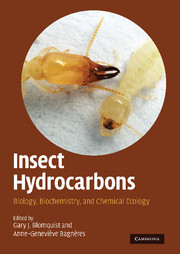Book contents
- Frontmatter
- Contents
- List of contributors
- Foreword
- Acknowledgments
- Part I Chemistry, Biochemistry, and Physiology
- Part II Chemical Communication
- 10 Perception and olfaction of cuticular compounds
- 11 Nestmate recognition in social insects and the role of hydrocarbons
- 12 Cuticular hydrocarbon cues in the formation and maintenance of insect social groups
- 13 Hydrocarbon profiles indicate fertility and dominance status in ant, bee, and wasp colonies
- 14 Chemical deception/mimicry using cuticular hydrocarbons
- 15 Behavioral and evolutionary roles of cuticular hydrocarbons in Diptera
- 16 Contact recognition pheromones in spiders and scorpions
- 17 Hydrocarbons as contact pheromones of longhorned beetles (Coleoptera: Cerambycidae)
- 18 Polyene hydrocarbons, epoxides, and related compounds as components of lepidopteran pheromone blends
- 19 Volatile hydrocarbon pheromones from beetles
- 20 Future directions in hydrocarbon research
- Index
20 - Future directions in hydrocarbon research
from Part II - Chemical Communication
Published online by Cambridge University Press: 18 May 2010
- Frontmatter
- Contents
- List of contributors
- Foreword
- Acknowledgments
- Part I Chemistry, Biochemistry, and Physiology
- Part II Chemical Communication
- 10 Perception and olfaction of cuticular compounds
- 11 Nestmate recognition in social insects and the role of hydrocarbons
- 12 Cuticular hydrocarbon cues in the formation and maintenance of insect social groups
- 13 Hydrocarbon profiles indicate fertility and dominance status in ant, bee, and wasp colonies
- 14 Chemical deception/mimicry using cuticular hydrocarbons
- 15 Behavioral and evolutionary roles of cuticular hydrocarbons in Diptera
- 16 Contact recognition pheromones in spiders and scorpions
- 17 Hydrocarbons as contact pheromones of longhorned beetles (Coleoptera: Cerambycidae)
- 18 Polyene hydrocarbons, epoxides, and related compounds as components of lepidopteran pheromone blends
- 19 Volatile hydrocarbon pheromones from beetles
- 20 Future directions in hydrocarbon research
- Index
Summary
The research on insect hydrocarbons as semiochemicals has taken a huge leap forward in the past three decades. A crude citation search using the terms “hydrocarbon” and “pheromon” (Thompson ISI) dating from 1965 to 1982, when the first large review of the chemical ecology of hydrocarbons was published (Howard and Blomquist, 1982), revealed 10 citations. A comparable search from 1983 to 2005, the publishing year of the second review by the same authors (Howard and Blomquist, 2005), and using the same terms, revealed 483 citations. Despite the explosion of knowledge regarding all facets of hydrocarbon biology, we are only now beginning to understand their complex role in communication. Here we attempt to indicate some areas of future hydrocarbon research that are expected to enhance our understanding of these structurally simple but biologically important molecules.
The ubiquitous occurrence of hydrocarbons and their multifaceted function in insects present the biggest challenge
Hydrocarbons provide an excellent model system for studying the evolution of semiochemicals by co-option, but also present an immense challenge to research. The ubiquitous occurrence of hydrocarbons in the epicuticle and tissues that possess cuticular intima has facilitated their isolation and structure elucidation, but is also one of the major obstacles in deciphering their role in communication. Other confounding factors include the fact that in most cases they occur as highly complex mixtures and, at least for cuticular hydrocarbons, multifaceted functions have been assigned to them.
- Type
- Chapter
- Information
- Insect HydrocarbonsBiology, Biochemistry, and Chemical Ecology, pp. 477 - 485Publisher: Cambridge University PressPrint publication year: 2010
- 2
- Cited by

